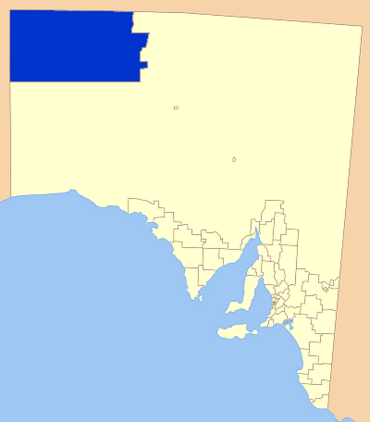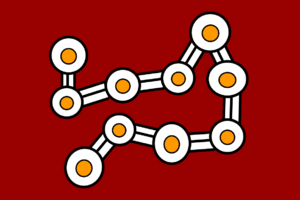Aṉangu Pitjantjatjara Yankunytjatjara facts for kids
Quick facts for kids Aṉangu Pitjantjatjara YankunytjatjaraSouth Australia |
|||||||||||||||
|---|---|---|---|---|---|---|---|---|---|---|---|---|---|---|---|

Location of the Anangu Pitjantjatjara Yankunytjatjara
|
|||||||||||||||
| Established | 1981 | ||||||||||||||
| Area | 103,000 km2 (39,768.5 sq mi) | ||||||||||||||
| Council seat | Umuwa | ||||||||||||||
| Region | Far North | ||||||||||||||
| State electorate(s) | Giles | ||||||||||||||
| Federal Division(s) | Grey | ||||||||||||||
 |
|||||||||||||||
| Website | Aṉangu Pitjantjatjara Yankunytjatjara | ||||||||||||||
|
|||||||||||||||
The Aṉangu Pitjantjatjara Yankunytjatjara, often called APY Lands or the Lands, is a very large area in remote north-west South Australia. It is a special local government area for Aboriginal people. The Aṉangu people, especially the Pitjantjatjara, Yankunytjatjara, and Ngaanyatjarra groups, live here.
The way the APY Lands are run is set out in the Anangu Pitjantjatjara Yankunytjatjara Land Rights Act 1981. This law means an elected board manages the area. This board reports to the Premier of South Australia. The main office for the APY is in Umuwa. A big part of the APY Lands used to be called the North-West Aboriginal Reserve.
Contents
Time Zone
The APY Lands use Australian Central Standard Time (UTC+9:30). This is the same time as Darwin in the Northern Territory. Unlike the rest of South Australia, the APY Lands do not use daylight saving time. This is because they are close to the Northern Territory border.
History of the APY Lands
Early Times
The Pitjantjatjara and Yankunytjatjara people, known as aṉangu, have lived in this area for thousands of years. Even after the British started settling Australia in 1788, the aṉangu were mostly left alone. They only had rare meetings with European explorers.
The 1900s
In 1921, the South Australian Government created the North-West Aboriginal Reserve. This was because white settlers were moving closer to the aṉangu traditional lands. This Reserve covered most of what is now the APY Lands. However, the eastern part was used for European farms.
In 1937, the Presbyterian Church started the Ernabella Mission. This mission was set up on the Lands at a place now called Pukatja. By the 1950s, many aṉangu lived at the Ernabella Mission. Others lived and worked at camps on nearby farms.
To stop the mission from getting too crowded, the Church opened new communities. In 1961, they started Amata (first called Musgrave Park). They also started Kaltjiti (then called Fregon).
In 1968, the South Australian Government set up Indulkana. This was to help aṉangu living on farms who were finding it hard to get work. The land around Indulkana was then made into the Indulkana Aboriginal Reserve.
The Aṉangu Pitjantjatjara Yankunytjatjara group was officially formed in 1981. This happened when the Anangu Pitjantjatjara Yankunytjatjara Land Rights Act 1981 was passed. This law gave land rights to the Pitjantjatjara, Yankunytjatjara, and Ngaanyatjarra groups.
"Ara Irititja" is a special project that started in 1994. It collects and records old stories and information about the Aṉangu people. This helps to keep their history alive and teach it to new generations.
The 2000s
By 2007, there had not been much economic growth in the area. There were some ideas for mining, but the aṉangu were worried. They were concerned about how mining might affect sacred sites and the environment.
A report in 2004 looked at problems with the 1981 Act. It found that the law had not fixed social and economic issues. It suggested that police should have a permanent presence in the area.
In 2007, the South Australian Government announced a big plan. They would spend money to improve housing and law enforcement in the APY Lands. This included building new police stations.
In 2009, a new law was passed about the opal-mining town of Mintabie. This law changed how licenses worked for homes and businesses there. A report in 2017 suggested closing Mintabie. Control of the town went back to the APY Lands in 2019.
In March 2024, the Kulilaya Festival was held in Umuwa. It celebrated 40 years since the 1981 APY Land Rights Act. The festival was delayed for three years because of the COVID-19 pandemic. Artists, musicians, and dancers shared their history and stories. Kulilaya means "listen" and was the name of a land rights protest song.
Geography and Location
The APY Lands are home to several mountain ranges. These include the Musgrave Ranges, Mann Ranges, and Tomkinson Ranges. The area also has isolated hills and large sandhill plains. APY people also have connections to land in the Northern Territory and Western Australia.
Geology
Underneath the APY Lands is a large palaeovalley. This is an ancient, buried river. Maps of this geological feature have been translated into Pitjantjatjara. This helps local people understand the land.
Near Kaltjiti, there is a long strip of limestone. In 2019, a new water source was found here. This area is one of only two places in the world with landlocked tectonic plates. Samples from drilling suggest the rocks are 5 to 10 million years old.
Nearby Areas
To the north of the APY Lands is the MacDonnell Shire in the Northern Territory. Western Australia is to the west. To the south is Maralinga Tjarutja.
The Outback Communities Authority helps manage public services in other large areas of South Australia. These areas are next to the APY Lands.
Communities and Towns
The APY Lands have many communities and settlements. Many of these are in the Musgrave Ranges.
The main communities include:
Larger homelands are:
Umuwa is the main administrative centre for the APY Lands. Mintabie was an opal-mining town. It was leased to the South Australian Government until 2019, when its residents moved out.
Here is a list of Aboriginal communities (c) and homelands (h):
- Amata (c)
- Indulkana (c)
- Irintata (h)
- Iwantja (c)
- Kaljiti/Fregon (c)
- Kalka (h)
- Kanpi (h)
- Mimili (c)
- Murputja (c)
- Nyapari (h)
- Pipalyatjara (c)
- Pukatja/Ernabella (c)
- Tjurma (h)
- Turkey Bore (h)
- Umuwa – administrative centre
- Watarru (c)
- Watinuma (h)
- Yunyarinyi (h)
How the APY Lands are Governed
The Anangu Pitjantjatjara Yankunytjatjara Land Rights Act 1981 sets out how the area is governed. An elected board manages the lands and reports to the Premier of South Australia. This board also hires a general manager.
The main jobs of the APY board are:
- To find out what traditional owners want for their land.
- To protect the interests of traditional owners.
- To talk with people who want to use or visit the land.
- To manage the land owned by Aṉangu Pitjantjatjara Yankunytjatjara.
The APY Lands are freehold lands, meaning they are owned by the Aboriginal people. Visitors need a permit to enter any community.
Electoral Areas
The Anangu Pitjantjatjara Yankunytjatjara Lands Rights (Miscellaneous) Amendment Act 2016 set up seven areas for elections. These areas choose the members of the APY executive board.
People of the APY Lands
2016 Census Information
The 2016 census collected facts about the people living in the APY Lands:
- There were 2,276 residents.
- More than 83% of people were Indigenous Australians.
- Most people (91.5%) were born in Australia.
- The average age was 28 years old.
- Many people spoke Pitjantjatjara (65.6%) at home. English was spoken by 12.9%.
- About 43% of people worked full-time.
- Most homes (91.3%) were rented.
- Many homes (45%) did not have a car.
- About 36% of homes had internet access.
- Largest Community Populations
Access and Services
Road Upgrades
A big project is upgrading the Main Access Road. This road connects the APY Lands to the Stuart Highway. The upgrade will make travel safer and help with delivering food and other supplies. It will also improve access to jobs. Construction started in 2017 and is expected to finish by 2021.
Community Services
Anangu Pitjantjatjara Services (AP Services) provides important services. These include roads and housing. Regional Anangu Services Aboriginal Corporation (RASAC) is the biggest employer of APY people. It offers services like housing, airport maintenance, building repairs, and fuel supplies.
Housing
Housing is a major issue in the APY Lands. The government is working on new plans to improve housing for Aboriginal communities. Many families are still waiting for homes. It is important to keep building new houses and maintaining old ones.
Police Services
As of 2018, there are police stations in Amata, Ernabella, Mimili, Murputja, Umuwa, and Marla. Special police support, including domestic violence investigators, is based in Umuwa. A new, permanent police complex is being built in Umuwa. It will help police work closely with child protection agencies.
Water Supply
SA Water runs plants that treat water from local bores. These plants are in Indulkana, Mimili, Kaltjiti (Fregon), and Yunyarinyi (Kenmore Park).
In 2019, a new water source was found near Kaltjiti. This water is about 90 meters underground. It is very pure and has low salt levels. Elders hope this water can help support cattle farming. This could create jobs and industries for the communities.
Feral Camels
In January 2020, the South Australian government started a plan to control feral camels. Many camels were destroying infrastructure and looking for water. They were also harming plants, polluting water, and damaging cultural sites. Professional shooters were used to remove thousands of camels from helicopters.
Art in the APY Lands
The APY Lands are famous for their talented artists. These artists often win awards and are featured in major exhibitions. For example, in 2017, APY artists received 25 nominations for the Telstra National Aboriginal & Torres Strait Islander Art Awards. Vincent Namatjira won the Archibald Prize. APY artists have also won or been shortlisted for many other important art prizes.
APY Art Centre Collective
The APY Art Centre Collective is a group of ten art businesses. These businesses are owned and run by Indigenous people. They help artists from across the Lands sell their work and connect with others. The idea started in 2013 to help Aṉangu artists create a network.
The Collective helps find new markets for the art. It also helps increase income for each art centre. Working together makes the artists stronger and helps prevent them from being taken advantage of.
The Collective has galleries in Darlinghurst, Sydney, and Adelaide. The Adelaide gallery, called APY Gallery Adelaide, also has a studio space. This allows artists to keep working when they visit Adelaide for healthcare or family. A large part of the money from art sales goes back to the communities. This is often the only income source apart from government support.
The art centres that are part of the Collective include:
- Tjala Arts (at Amata)
- Ernabella Arts
- Kaltjiti Arts
- Iwantja Arts
- Mimili Maku Arts
- Tjungu Palya (Nyapari)
- Ara Irititja (APY project)
- Maruku Arts (Yulara)
- Tjanpi Desert Weavers
- Umoona Art Centre (Coober Pedy)
In 2019, 17 APY artists were finalists for the Wynne Prize. In 2020, during the COVID-19 pandemic in Australia, the Adelaide gallery moved online. Artists Sammy Lyons and Leah Brady were finalists in the Telstra National Aboriginal & Torres Strait Islander Art Awards.
In April 2021, an exhibition called Irititja – Old, Kuwaritja – New, Ngali – Us was opened. It showed the work of artist Sally Scales and her mother, Josephine Mick.
See Also
 In Spanish: Anangu Pitjantjatjara Yankunytjatjara para niños
In Spanish: Anangu Pitjantjatjara Yankunytjatjara para niños


